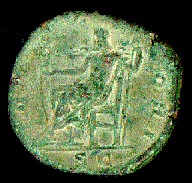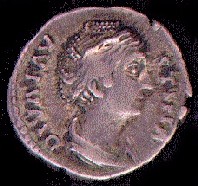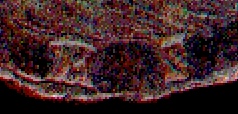Brad's Introduction to Ancient Coins
I mostly collect ancient Roman coinage because it is more common
and inexpensive. The earlier Greek coins are often more beautiful,
but their larger, artistic silver coins ("tetradrachs")
usually cost five-hundred dollars and it goes up from there.
So I stick mostly to Roman coins, and find plenty to interest me there.
This and the remaining pages will discuss Roman coins exclusively,
except when otherwise indicated.
The coinage of Rome can be broken roughly into four periods:
early and late Republican, and early and late Imperial.
Again, mostly due to cost, I concentrate on coins of the Empire,
which began with Octavian being proclaimed Augustus in 27 BC.
 By the time of Augustus, the silver denarius has been in use
for about 180 years. To this, Augustus added a large bronze
coin, the sestertius, which was one-quarter of a denarius in value,
and other lesser coins. The reverse of a poor example of a sestertius
can be seen to the right. This coin is from Severus Alexander, who
was Emperor from 222 to 235 AD. As has always been the case, coins
received considerable wear from circulation, and today, a very worn coin
is worth much less than a "mint state" coin.
That will be discussed on the page about
grading ancient coins.
By the time of Augustus, the silver denarius has been in use
for about 180 years. To this, Augustus added a large bronze
coin, the sestertius, which was one-quarter of a denarius in value,
and other lesser coins. The reverse of a poor example of a sestertius
can be seen to the right. This coin is from Severus Alexander, who
was Emperor from 222 to 235 AD. As has always been the case, coins
received considerable wear from circulation, and today, a very worn coin
is worth much less than a "mint state" coin.
That will be discussed on the page about
grading ancient coins.
These larger coins allowed Emperors such as Augustus to put
more titles for themselves on the inscriptions of the coins.
For example, one read
CAESAR AVGVSTVS DIVI F PATER PATRIAE
!
The "F" stood for FILIVS, and the entire inscription translates to
Caesar Augustus, son of god, father of the country.
Augustus tried to appear modest at times but this wasn't one of them.
 Emperors also put their wives, children, and occasionally other family members
on their coins. Shown at left is a denarius of Faustina Senior,
the wife of the Emperor Antoninus Pius, who ruled from 138 to 161.
After her death early in his reign, Pius had many different coins
struck in her honor, including this one.
The inscription reads
DIVA FAVSTINA
("diva" translates to "divine" or "deified") which indicates
that she had died before this coin was struck.
Coins of the various empresses are one of my interests,
as they are more varied, showing in elaborate detail
the hair styles of the different eras.
Some things never change!
Emperors also put their wives, children, and occasionally other family members
on their coins. Shown at left is a denarius of Faustina Senior,
the wife of the Emperor Antoninus Pius, who ruled from 138 to 161.
After her death early in his reign, Pius had many different coins
struck in her honor, including this one.
The inscription reads
DIVA FAVSTINA
("diva" translates to "divine" or "deified") which indicates
that she had died before this coin was struck.
Coins of the various empresses are one of my interests,
as they are more varied, showing in elaborate detail
the hair styles of the different eras.
Some things never change!
In the early Imperial period, coins came in two types,
Imperial and Provincial.
Imperial coins were minted in Rome (and eventually a number
of other cities), and had Latin inscriptions.
Some basic information about the denominations of these
coins can be found on
this page.
The later Imperial period
begins with the Emperor Diocletian's reforms of the coinage
soon after he became the sole Emperor in 285 AD.
In this period, inscriptions are always in Latin, and coins usually
have a mint mark indicating where they were produced.
"Provincial" coins were mostly minted in Greek cities,
and had inscriptions in Greek provinces controlled by the Roman Empire.
These coins, mostly silver and bronze,
circulated mostly in a local area
and had local denominations different from the Imperial coins.
By the third century, Rome was starting a long decline
that would culminate in the fall of Rome in the late
fifth century. This decline can be seen in its coins,
as less and less silver was used, and inflation increased
in the empire. The denarius began to
be replaced in the middle of the third century by a
double-denarius. Today, this is often referred to by
the difficult name "antoninianus," after the family name of
the emperor Caracalla, who first issued it.
While it was set or "tariffed" at two denarii, it
did not have the equivalent of two denarii in silver.
As time went on, new antoninianii had less and less
silver until the late third century whenit was a
bronze coin with a wash of silver over the two sides.
Most of the coins found from the Late Roman Empire are bronze,
but a number of emperors tried to make reforms
in the coinage. Most often these had little success,
at least in the long run.
As the Empire declined, so did the size of its
coins, and eventually, the quality of the artwork
became quite poor. As these changes occurred,
many new denominations were created, and we do not
have names for some of these, so we just refer to
them by their metal type, Æ (bronze), and size, with
Æ1 being the largest and Æ4 being the smallest --
sometime barely larger than half the size of today's penny.
Roughly Æ1 is over 25 mm in diameter, Æ2 is
from 21 to 25 mm, Æ3 is 17 to 21 mm, and Æ4
coins are under 17 mm. If you see a coin's size noted
as Æ with a number greater than 4, this indicates
the diameter in mm. So Æ22 would be 22 mm across.
This is often used for Provincial (and non-Roman Greek)
bronze coins.
 As power in the empire during this period was more
distributed, often with multiple emperors dividing control
of the Empire into separate geographical areas, coins
were minted at a larger number of cities, and starting
in the middle of the third century, a mint mark (e. g., "RS" on
the coin at right) was
placed on many coins in the "exergue" (pronounced "ECK-surge")
area below the design on the reverse of the coins. The mint marks,
and letters and symbols added to them, and on other
places on these coins, allow us to determine which city
a coin was minted in, and often date its production
to within a year or two!
As power in the empire during this period was more
distributed, often with multiple emperors dividing control
of the Empire into separate geographical areas, coins
were minted at a larger number of cities, and starting
in the middle of the third century, a mint mark (e. g., "RS" on
the coin at right) was
placed on many coins in the "exergue" (pronounced "ECK-surge")
area below the design on the reverse of the coins. The mint marks,
and letters and symbols added to them, and on other
places on these coins, allow us to determine which city
a coin was minted in, and often date its production
to within a year or two!
Continue to Buying Ancient Roman Coins.
If you have any questions or comments, please
send e-mail to me at
 .
.
Last updated January 25, 2024.
 By the time of Augustus, the silver denarius has been in use
for about 180 years. To this, Augustus added a large bronze
coin, the sestertius, which was one-quarter of a denarius in value,
and other lesser coins. The reverse of a poor example of a sestertius
can be seen to the right. This coin is from Severus Alexander, who
was Emperor from 222 to 235 AD. As has always been the case, coins
received considerable wear from circulation, and today, a very worn coin
is worth much less than a "mint state" coin.
That will be discussed on the page about
grading ancient coins.
By the time of Augustus, the silver denarius has been in use
for about 180 years. To this, Augustus added a large bronze
coin, the sestertius, which was one-quarter of a denarius in value,
and other lesser coins. The reverse of a poor example of a sestertius
can be seen to the right. This coin is from Severus Alexander, who
was Emperor from 222 to 235 AD. As has always been the case, coins
received considerable wear from circulation, and today, a very worn coin
is worth much less than a "mint state" coin.
That will be discussed on the page about
grading ancient coins.
 Emperors also put their wives, children, and occasionally other family members
on their coins. Shown at left is a denarius of Faustina Senior,
the wife of the Emperor Antoninus Pius, who ruled from 138 to 161.
After her death early in his reign, Pius had many different coins
struck in her honor, including this one.
The inscription reads
DIVA FAVSTINA
("diva" translates to "divine" or "deified") which indicates
that she had died before this coin was struck.
Coins of the various empresses are one of my interests,
as they are more varied, showing in elaborate detail
the hair styles of the different eras.
Some things never change!
Emperors also put their wives, children, and occasionally other family members
on their coins. Shown at left is a denarius of Faustina Senior,
the wife of the Emperor Antoninus Pius, who ruled from 138 to 161.
After her death early in his reign, Pius had many different coins
struck in her honor, including this one.
The inscription reads
DIVA FAVSTINA
("diva" translates to "divine" or "deified") which indicates
that she had died before this coin was struck.
Coins of the various empresses are one of my interests,
as they are more varied, showing in elaborate detail
the hair styles of the different eras.
Some things never change!
 As power in the empire during this period was more
distributed, often with multiple emperors dividing control
of the Empire into separate geographical areas, coins
were minted at a larger number of cities, and starting
in the middle of the third century, a mint mark (e. g., "RS" on
the coin at right) was
placed on many coins in the "exergue" (pronounced "ECK-surge")
area below the design on the reverse of the coins. The mint marks,
and letters and symbols added to them, and on other
places on these coins, allow us to determine which city
a coin was minted in, and often date its production
to within a year or two!
As power in the empire during this period was more
distributed, often with multiple emperors dividing control
of the Empire into separate geographical areas, coins
were minted at a larger number of cities, and starting
in the middle of the third century, a mint mark (e. g., "RS" on
the coin at right) was
placed on many coins in the "exergue" (pronounced "ECK-surge")
area below the design on the reverse of the coins. The mint marks,
and letters and symbols added to them, and on other
places on these coins, allow us to determine which city
a coin was minted in, and often date its production
to within a year or two!
 .
.